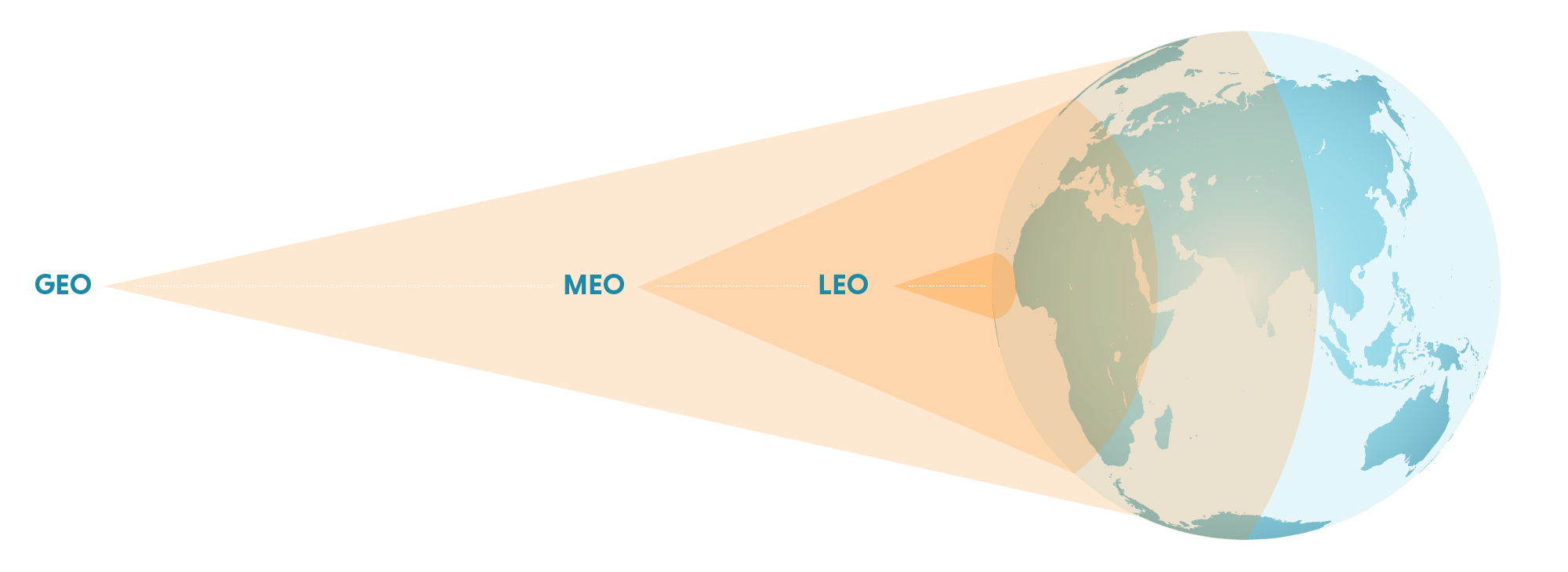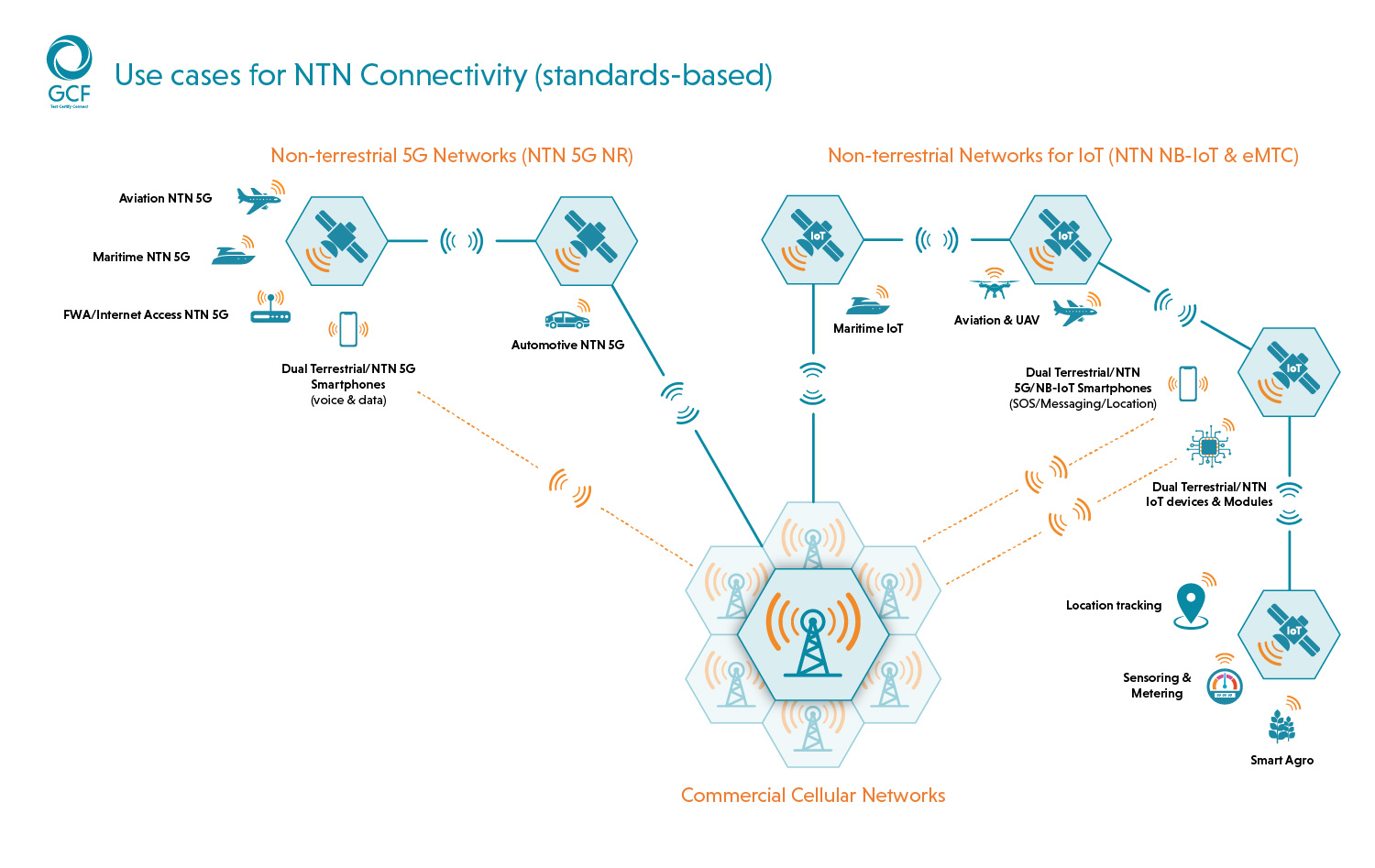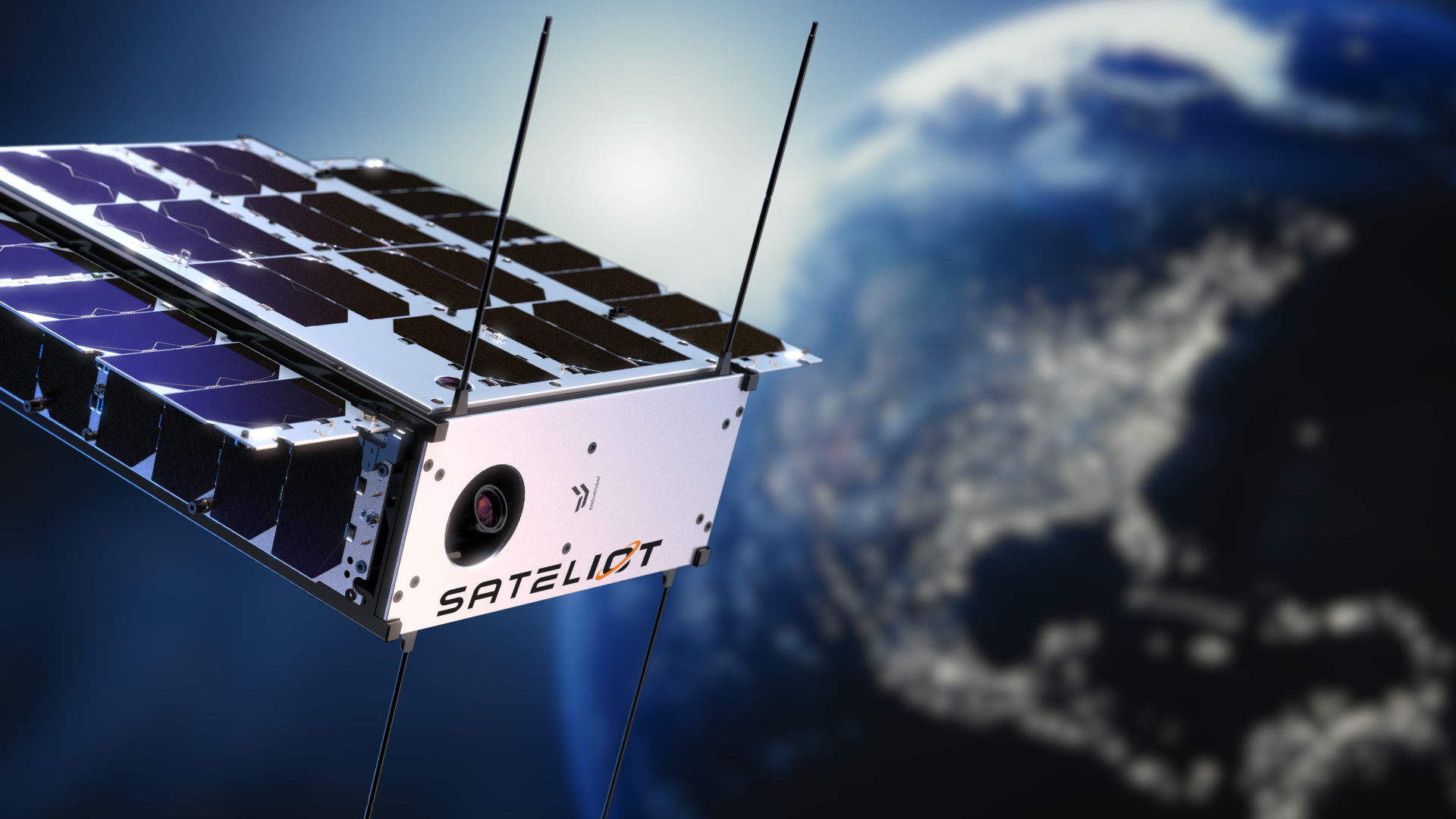The Non-Terrestrial Network opportunity – how GCF certification is enabling a rapid transformation
- 15 Jan 2024
- Carlos Pedraz
Introduction
In this article, we will look at certification for devices connecting to Non-Terrestrial Networks (NTNs), using 3GPP wireless communications standards over satellite communications, how the Global Certification Forum (GCF) is extending its activities to cover this sector and how we will address challenges arising. GCF works closely with standards bodies, network operators -both terrestrial and satellite-based, industry associations, device manufacturers and test industries to develop its certification programs, and to keep up with the latest additions to communication standards.
Since the first satellite, Sputnik 1, was launched in 1957, our ability to communicate using non-terrestrial radio connections has been hugely transformed. Within a year of Sputnik’s maiden flight, the USA had launched SCORE, the first purpose-built communications satellite, and today there are thousands of satellites orbiting our planet.
Satellite orbits are usually categorised into three main types (see Figure 1): LEO (Low Earth Orbit), MEO (Medium Earth Orbit) and GEO (Geostationary Earth Orbit). For communications, LEO orbits are nowadays the most popular: it’s easier to launch a satellite into a low orbit, typically around 300 km to 1,500 km, and being closer to the ground means latency is lower, and devices need less powerful radios. However, their lower orbit does mean that LEO satellites change their position relative to the ground more quickly than MEO alternatives, so the LEO satellites are often deployed in a group that works together to provide frequent or continuous coverage, called a constellation.
GEO satellites, on the other hand, are static in relation to Earth rotation, but are deployed at a much higher orbit (around 36,000 km), leading to much higher latency times (around 550 ms RTT) and requiring higher power consumption.

Figure 1: Differences in LEO vs MEO vs GEO
Demand for satellite communications is growing fast, and this is accelerating the launch of LEO satellites. Many projects around the world, including relatively new companies like Starlink, Sateliot, Amazon’s Project Kuiper, AST SpaceMobile or China Satellite Network Group, are already active or being prepared to provide direct connectivity to devices on the ground, without needing an intermediate satellite antenna. While other, more established satellite-players, such as Eutelsat (that recently acquired OneWeb), Viasat or Globalstar, are also working to deliver multi-orbit (typically GEO and LEO) connectivity. However, there are technical challenges to be solved, including extra latency from round-trip delays, and frequency shifts due to the satellite's movement in relation to the ground, called Doppler shifts.
As with any mobile communications technology, standards are essential to guarantee good interoperability between devices and satellite networks. In order to provide operators the confidence that products meet these standards and can be safely deployed on their networks, certification is vital.
The satellite communications opportunity
NTNs can deliver Internet access to areas not covered by terrestrial mobile networks, covering the most remote regions of our planet, as well as oceans and flight paths. With 600 million people living outside the range of a mobile network, there’s a clear need to expand coverage – as well as a potential $30 billion revenue increase from consumers, which is up for grabs by operators (Source: GSMA Intelligence). Extending terrestrial networks further is becoming an expensive option today, particularly for the areas with the lowest population density. NTNs can provide a cost-effective way of reaching areas that have been missed so far, and of improving patchy coverage for millions of people.
As well as providing voice and data for smartphones and consumer devices, NTNs will transform the capabilities of the Internet of Things (IoT). Applications for NTN IoT connectivity will include two-way messaging, emergency services, telemetry, location tracking, fleet management, smart agriculture, and remote monitoring and control of infrastructures – with the low cost and power consumption of IoT devices opening up new opportunities to gather enormous amounts of actionable data.
GSMA Intelligence estimates the business-to-business market for NTN will reach around $10 billion per year by 2035, which is about 25% of the existing connectivity revenues from IoT use cases, and that by 2035 around 1.9 billion IoT devices will be addressable by device-to-device (D2D) satellite links.
Consumer Mobile applications over NTNs will include not only data access, but also messaging, voice calls, navigation, and contacting emergency services. Automotive is another potentially huge market, with connected cars and fleet tracking leveraging NTN connectivity becoming common on our roads.

Figure 2: Samples of satellite use cases for standards-based NTN connectivity
Early consumer products are already available, with satellite links directly to user devices, that do not necessarily rely on 3GPP NTN standards. For example, latest generations of Apple iPhone devices enable users to contact emergency services when they have no mobile or Wi-Fi coverage, by texting via a satellite.
But the first devices using 3GPP NTN Standards are already commercial, starting with Motorola, which has launched Defy Satellite Link, a Bluetooth accessory for consumers that connects to any smartphone to provide two-way text messaging and SOS emergency contact service over satellite, using NTN NB-IoT connectivity. And many other smartphone and module vendors have been announced by Qualcomm, Mediatek and Samsung supporting NTN NB-IoT connectivity.
Standards for NTN
The main standards for NTNs and satellite connectivity are being defined by the 3GPP, the organisation responsible for defining 5G and other wireless communication standards. 3GPP Rel. 17 has added two main specifications: NTN NB-IoT for IoT use cases, and NTN 5G NR for data and voice-oriented applications. And additional enhancements are being introduced in 3GPP Rel. 18.
GCF has been actively working with key industry players since the beginning of 2023 to introduce NTN standards into the GCF Certification Program, starting with NB-IoT, which GCF expects to activate soon in 2024. This will be extended afterwards to include NTN 5G NR.
The GCF certification programme assures reliable device-network interoperability, as well as contributing to a reduction in testing costs, and accelerated time-to-market. This will help speed up the market availability of certified 3GPP Rel-17 NTN NB-IoT chipsets and modules for both GEO (GSO) and LEO (NGSO) constellations.
Satellite-focused companies have started to join GCF, and are key to providing expertise to the development of certification capabilities for devices connecting to satellite networks. So far, NTN-related work items are being introduced in the regular GCF processes and agreement groups mainly by existing members. This includes manufacturers of devices and systems on chip (SoCs), terrestrial operators focused on or partnering with satellite operators, and test industry businesses.
Moving beyond the organisation’s traditional membership base, satellite operators are encouraged to participate in GCF activities, and their input will enable the specific needs and challenges of satellite connectivity to be addressed thoroughly.

Figure 3: LEO satellite in orbit, courtesy of Sateliot
GCF: status of NTN certification program
Let’s look in a little more detail at the current status of GCF’s certification program for NTN. For IoT use cases, the certification program for NTN NB-IoT devices will likely be activated in the first quarter of 2024. Initial Frequency bands n255 (L-band) and n256 (S-band) were introduced in July 2023, and additional bands can be included in the process if requested and supported by GCF members. The certification program for NTN 5G NR devices will follow after NTN NB-IoT. With field trials for NTN still being analysed and developed, the initial focus is set on conformance testing. Subject to GCF members approval, certification of NTN NB-IoT devices could start with conformance test cases only, until NTN commercial networks are available and test specifications for field trials are made available.
The GSMA TSG (Terminal Steering Group) provides the Test Specification (GSMA TS.11) for field trials in terrestrial networks being used in GCF Certification. It is constantly evolving and, as of December 2023, is already on version v43. Field trials for NTN connectivity are not yet supported by TS.11 specification, but GSMA is now working on its development, following a Study Item completed in 2023. The focus is set on the definition of NTN-IoT test cases (for both GEO and LEO), and field trials are a key area.
However, while a way forward to test real implementations is desirable, there are a number of challenges to overcome. This includes technical issues due to the movement of satellites and the great distance from devices under test, such as Doppler shift, Faraday rotation, and high attenuation. But in addition, there are also likely issues due to the low availability of satellite networks and the density of satellites, as well as limited access to GCF RTOs (Recognised Test Organisations) to Subscriptions, test spots, and information about constellations.
Conclusion: take an active role
Satellite communication is going through a period of rapid change, with the number of satellites launched into low earth orbits increasing dramatically. Along with technology improvements, this means that NTNs are about to become a far more common part of our lives, and a key part of IoT connectivity. As certification for new NTN standards is developed, GCF welcomes active engagement from the satellite and device industry – both within GCF itself, and in standards bodies and forums such as 3GPP, GSMA and Global Satellite Operators Association (GSOA). We encourage new and existing GCF members to join and participate in our activities, and to help build a certification scheme for NTN connectivity – thus helping this new market sector to develop rapidly and robustly.


